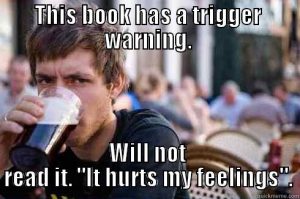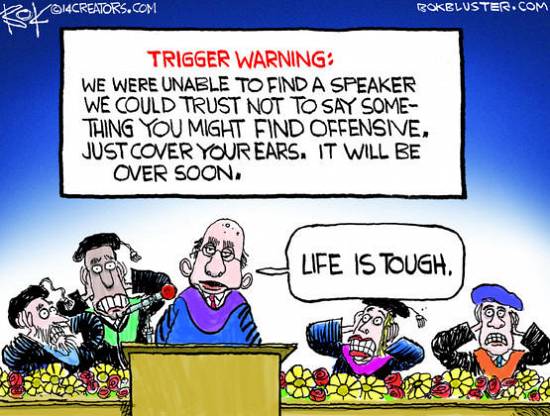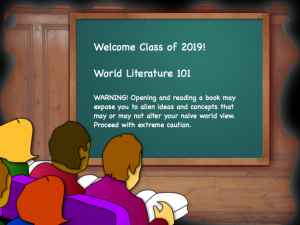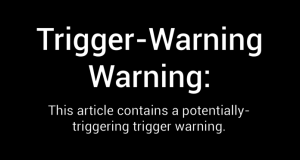
I was recently listening to an episode of The Sunday Edition (a popular weekly radio show on the CBC, Canada’s national broadcaster), on the topic of free speech on university campuses, and was intrigued by the following exchange between host Michael Enright and his guest James Turk, who is director of The Centre of Free Expression at Ryerson University in Toronto (give a listen to their conversation here).
Michael Enright: How have we arrived at a point where we tend to believe it’s dangerous for a student to hear someone talk?
James Turk: Well, fortunately, I don’t think most of us think it’s dangerous … to be fearful of a student hearing offensive things.
ME: What about safe havens and all that kind of thing? Trigger warnings and all that?
JT: Trigger warnings are a very American phenomenon … a demand that’s been widespread in the United States that faculty, before they assign a certain reading or give a lecture, warn students about what might trigger concerns or difficulties for them. It’s never really caught on very seriously in Canada and there’s been a very sound critique of it in the United States. First of all, what may trigger a person could be anything. I may have been mugged by a guy wearing a red sweater two years ago in New York City and so when I see a read sweater I get … uh [chuckles] and so to say before you can read a novel you have to be advised of all things, uh, so, that idea comes from a good source, saying, well, we’re concerned with students not being traumatized and so forth, but that’s not a way to deal with that issue. If a student has a serious psychological issue with something they need proper mental health counselling, they don’t need their professor to try to anticipate what might set them off.
My immediate reaction to this exchange was frustration at their distortion of what I understand trigger warnings and safe spaces to mean (more on this below), and their conflation between conflicts involving student groups and invited guest speakers on some university campuses (e.g., Milo Yiannopoulos at Berkeley), with the variety of ways that these concepts are used in the classroom. Enright and Turk’s classifications are not uncommon, however, and appear to have a fair bit of support in academic circles.

For example, in her 2016 essay “Un/Safe Disclosures: Scenes of Disability and Trauma,” Alison Kafer notes how in a 2014 report from the American Association of University Professors (AAUP), trigger warnings are described as “counter-productive to the educational experience” and a “threat to the academic experience” that place “comfort” over “intellectual engagement” and operate under the assumption that “students need to be protected rather than challenged” (1). These characterizations, coming from a significant academic body with nearly 50,000 members, are also echoed in a recent episode of Real Time with Bill Maher, where guest Salman Rushdie was asked by Maher, “what is the antidote to political correctness on college campuses?” to which Rushdie replied:
SR: The antidote is to ignore it and to speak severely to people who want to propagate it. I have to say, in my experience of the American academy, which is now getting on for twenty-years, I have never had a student say to me that he wanted a trigger warning or she wanted a safe space … I hear that it happens around the country … I have no personal experience with it.

Another panellist, New York Times columnist Bret Stephens, went on to comment that university administrators have been “cowed by small minorities of totalitarian minded students who just don’t want to hear anything except what they’re disposed to agree with.”
In contrast to these assumptions, Kafer quotes disability studies scholar Margaret Price, who instructs her students to practice “self-care” when engaging with difficult subject matter, such as violence, sexual assault, and racism, which is meant to acknowledge that some material may be traumatizing for students who have experienced such things. Price suggests that students who anticipate being triggered by such material might use strategies like engaging in a manual activity such as knitting or even leaving the room if they need to. Other options, such as providing a copy of lectures prior to class so that students can prepare for engaging with difficult material on their own terms, are examples of what she calls access, which is defined as the opposite of avoidance (or censorship).

This understanding and deployment of trigger warnings is consistent with how I have used them in my own classes, where they function much like advisories at the start of a movie — WARNING, this film contains scenes of graphic violence and sexuality that some viewers may find disturbing. As I typically have hijab wearing students in my classes, students who’ve come from war torn countries like Iraq and Syria, students of color, and, of course, women, providing a trigger warning before screening the documentary like Reel Bad Arabs is not a form of coddling, but is intended to enable students to grapple with difficult topics without being blindsided, traumatized, and left feeling uncomfortable in the learning environment that I, as their teacher, am responsible for making accessible (hence the idea of “safe spaces”).
While I maintain that my initial frustration with the segments on The Sunday Edition and Real Time with Bill Maher are justified, these examples are also useful instances for thinking about the gaps that always exist between how concepts are developed in particular spaces, such as the classroom, and the broader transformations and applications that they inevitably undergo as they filter through the public sphere, where competing ideologies, interests, and mediums of exchange, such as Twitter or the memes pictured here, re-shape their “public” meaning, for better and for worse.

Although I strongly prefer Price and Kafer’s descriptions and do encourage others to consider their usage of trigger warning and safe spaces, I have no doubt that some who have applied these ideas in the classroom and elsewhere have done so in ways that resemble the forms of censorship that Enright, Turk, Rushdie, and Stephens are concerned with. While it is clear that these dudes haven’t done their homework when it comes to the discourse and applications of these concepts, and thereby distort (consciously or not) the variety of ways that they have been conceptualized and applied, paying attention to the ideological prisms through which such ideas are filtered is perhaps a better way to analyze what is at work beyond the usual rhetorical tropes that we hear in this present moment.

Here I recall the opening lines of Hayden White’s book Tropics of Discourse (1978), when he writes:
Our discourse always tends to slip away from our data toward the structures of consciousness with which we are trying to grasp them; or, what amounts to the same thing, the data always resist the coherency of the image which we are trying to fashion of them (1).
White’s observations offer an important reminder that the concepts and ideas that we take up in everyday speech do not come ready-made, filled with self-evident meaning, but start from the structures of consciousness that mould and shape them in particular ways.
All of this being said, using trigger warnings in the way that Price and Kafer suggest can have the additional effect of helping students to think about how things like affect (e.g., emotion, personal experience, trauma, etc.), identity (e.g., gender, ethnicity, sexual orientation, etc.), and narrative structure (e.g., how we represent topics) always condition our relationship to knowledge (epistemology), and in ways that are not the same for everybody. In this sense, the careful use of trigger warnings has a lot to offer scholars, students, and others, as it helps to foreground the inevitable tension between knowledge and identity formation, which is anything but neutral.

Well argued! For the most part, I think you’re right. Where I think the “failing” occurs is with the notion that a student is justified in excusing him/her/(their?)self from a discussion in *anticipation* of “discomfort” (for lack of a better term). It seems to me there is a vast difference between “excuse yourself if you *are* triggered” and “excuse yourself if you *might* be triggered.” My understanding is that the best psychological theories hold up the notion that avoiding difficult experiences is detrimental to the individual’s mental/emotional well-being, and certainly, the best pedagogical theories hold up the notion that it is detrimental to the individual’s intellectual well-being. This is not to say that one should not give a heads-up of a controversial topic (that strikes me a simply polite). There are, however, logical outcomes that highlight the problematic nature of “anticipatory absence” (my term, if that ever catches on). Should a student in a religion course be excused because the discussion of Jesus as a historical figure without the concomitant discussion of Jesus as God Incarnate might be emotionally traumatic? “Absurd,” we might respond, but is this not the same sort of response the ‘hard-nosed’ teacher offers in response to the student who pre-emptively excuses herself from a discussion about rape? So on and so forth.
All that being said, I think my response still highlights a key issue you’ve brought to light: this debate is distorted. There are good, important arguments to be had, but they’re too often obscured by facile mischaracterizations of the various positions. Of course, it seems that *everything* these days is a facile mischaracterization of the position at hand. I blame Twitter. 😉
I agree with you when it comes to critiquing religion, especially when that’s the course or department in question. A decent course outline should be disclaimer enough when discussing Jesus, Mohammad, etc., in a critical historical fashion.
But if the topic is rape or scenes of extreme (visual or literary) violence (including racism), my experience in talking to several people about this is that it is done with actual victims of such forms of violence in mind who may be seriously traumatized to be blind-sided by such material in light of their prior experiences. That, for me, is a crucial distinction from the idea of “mere coddling” that is often trotted out against so-called trigger warnings and safe spaces. Having seen the effects of such things on some people, it’s a small curtesy that, as I argue in the post, should ideally enable difficult material rather than suppress it.